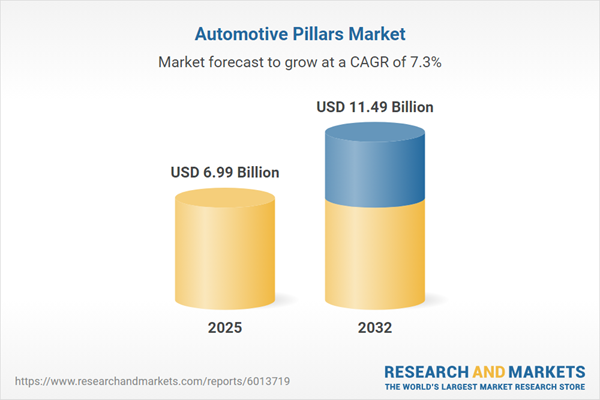Speak directly to the analyst to clarify any post sales queries you may have.
The automotive pillars market is transforming as technological advancements, shifting regulations, and evolving consumer expectations drive industry adaptation. Senior decision-makers must address increasing complexity through collaboration, innovation, and strategic focus.
Market Snapshot: Automotive Pillars Market Growth & Trends
The Automotive Pillars Market grew from USD 6.52 billion in 2024 to USD 6.99 billion in 2025. It is expected to continue growing at a CAGR of 7.33%, reaching USD 11.49 billion by 2032. This expansion reflects the market’s adjustment to rapid developments across electrification, connectivity, and regulations. Ongoing innovation is influencing vehicle design, supply chain management, and regional competitiveness, underlining the importance of adaptive strategy within the sector.
Scope & Segmentation
The report delivers comprehensive coverage of the Automotive Pillars Market, with extensive segmentation to inform targeted strategies:
- Vehicle Type: City Bus, Coach, Intercity Bus, Rigid Truck, Tipper, Tractor Unit, Cargo Van, Chassis Cab, Passenger Van, Pickup, Convertible, Coupe, Hatchback, MPV, Sedan, SUV
- Propulsion Type: Battery Electric, Fuel Cell Electric, Full Hybrid, Mild Hybrid, Plug-In Hybrid Electric, CNG, Diesel, Gasoline, LPG
- Transmission Type: Automatic, Manual
- Drivetrain: All Wheel Drive, Front Wheel Drive, Rear Wheel Drive
- Price Range: Economy, Luxury, Mid Range
- End Use: Commercial, Personal
- Regions: North America (United States, Canada, Mexico), Latin America (Brazil, Argentina, Chile, Colombia, Peru), Europe (United Kingdom, Germany, France, Russia, Italy, Spain, Netherlands, Sweden, Poland, Switzerland), Middle East (UAE, Saudi Arabia, Qatar, Turkey, Israel), Africa (South Africa, Nigeria, Egypt, Kenya), Asia-Pacific (China, India, Japan, Australia, South Korea, Indonesia, Thailand, Malaysia, Singapore, Taiwan)
- Key Companies: Toyota Motor Corporation, Hyundai Motor Company, General Motors Company, Stellantis N.V., Ford Motor Company, Honda Motor Co., Ltd., Nissan Motor Co., Ltd., SAIC Motor Corporation Limited
Key Takeaways for Decision-Makers
- Electrification is moving from early adoption to mainstream applicability, shaping product and supply chain priorities for OEMs and their partners.
- Integration of connectivity features is crucial, not just for enhanced infotainment but for operational efficiency and end-user engagement.
- Autonomous and driver-assist technologies are incrementally emerging, redefining expectations for safety and functionality.
- Strategic alliances, including those with technology providers and infrastructure partners, are accelerating the rollout of new mobility solutions.
- Market opportunities increasingly rely on software adaptability and ecosystem integration rather than solely hardware offerings.
- Segment granularity and regional nuances guide localization, ensuring product relevance and regulatory compliance in diverse markets.
Tariff Impact: Evolving U.S. Trade Policy and Strategic Realignment
Adjustments to U.S. tariff schedules in 2025 have compelled manufacturers to reassess global production footprints and adopt localization and nearshoring strategies. This shift is fostering tighter domestic supplier networks, with tiered suppliers adapting through partnerships and diversification. Modular approaches to research and development are emerging in response to heightened supply chain uncertainty, supporting risk mitigation and business continuity.
Methodology & Data Sources
The analysis draws from primary interviews with executives and in-depth reviews of filings, regulatory documentation, and publications. Quantitative modeling and structured qualitative assessments identify market drivers, with triangulation and expert workshops enhancing reliability and reducing bias.
Why This Report Matters
- Equips leaders with actionable segmentation and regional analysis to optimize strategy amid rapid industry transitions.
- Supports proactive decision-making by highlighting trending technologies and adaptive business models required for competitive positioning.
- Serves as a foundation for scenario planning, investment prioritization, and stakeholder alignment across the automotive value chain.
Conclusion
The automotive pillars market is shaped by transformative forces, from electrification to regulatory change. Informed strategy will depend on agile adaptation, robust partnerships, and targeted innovation to capture emerging opportunities.
Additional Product Information:
- Purchase of this report includes 1 year online access with quarterly updates.
- This report can be updated on request. Please contact our Customer Experience team using the Ask a Question widget on our website.
Table of Contents
3. Executive Summary
4. Market Overview
7. Cumulative Impact of Artificial Intelligence 2025
Companies Mentioned
The companies profiled in this Automotive Pillars market report include:- Toyota Motor Corporation
- Hyundai Motor Company
- General Motors Company
- Stellantis N.V.
- Ford Motor Company
- Honda Motor Co., Ltd.
- Nissan Motor Co., Ltd.
- SAIC Motor Corporation Limited
Table Information
| Report Attribute | Details |
|---|---|
| No. of Pages | 192 |
| Published | October 2025 |
| Forecast Period | 2025 - 2032 |
| Estimated Market Value ( USD | $ 6.99 Billion |
| Forecasted Market Value ( USD | $ 11.49 Billion |
| Compound Annual Growth Rate | 7.3% |
| Regions Covered | Global |
| No. of Companies Mentioned | 9 |









